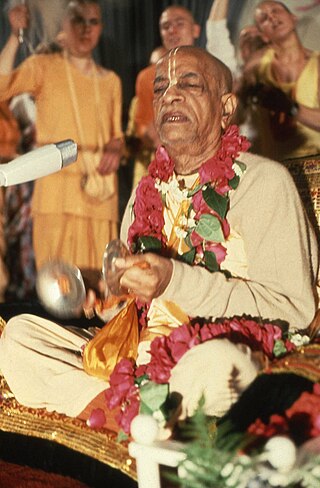
A. C. Bhaktivedanta Swami Prabhupada (1896–1977) was a spiritual, philosophical, and religious teacher from India who spread the Hare Krishna mantra and the teachings of “Krishna consciousness” to the world. Born as Abhay Charan De and later legally named Abhay Charanaravinda Bhaktivedanta Swami, he is often referred to as “Bhaktivedanta Swami”, "Srila Prabhupada", or simply “Prabhupada”.

The International Society for Krishna Consciousness (ISKCON), known colloquially as the Hare Krishna movement, is a Gaudiya Vaishnava Hindu religious organization. It was founded on 13 July 1966 in New York City by A. C. Bhaktivedanta Swami Prabhupada. Its main headquarters is located today in West Bengal, India.

Satsvarupa das Goswami is a senior disciple of Bhaktivedanta Swami Prabhupada, who founded the International Society for Krishna Consciousness (ISKCON), better known in the West as the Hare Krishna movement. Serving as a writer, poet, and artist, Satsvarupa dasa Goswami is the author of Bhaktivedanta Swami's authorized biography, Srila Prabhupada-lilamrta. After Prabhupada's death, Satsvarupa dasa Goswami was one of the eleven disciples selected to initiate future disciples. Satsvarupa dasa Goswami is one of the first few Westerners ordained by Bhaktivedanta Swami in September 1966. He is a Vaishnava writer, poet, and lecturer, who published over a hundred books including poems, memoirs, essays, novels, and studies based on the Vaishnava scriptures.
Bhakti Chaitanya Swami is a Gaudiya Vaishnava swami and a religious leader of the International Society for Krishna Consciousness. He is a member of its Governing Body Commission and is the leader of ISKCON in South Africa, the Baltic states and Russia.

Bhakti Charu Swami was an Indian spiritual leader of the International Society for Krishna Consciousness (ISKCON). He was also a disciple of ISKCON's founder A. C. Bhaktivedanta Swami Prabhupada.

Kirtanananda Swami, also known as Bhaktipada, was a Gaudiya Vaishnava guru and the co-founder of New Vrindaban, a Hare Krishna community in Marshall County, West Virginia, where he served as spiritual leader from 1968 until 1994.

Jayadvaita Swami, a Gaudiya Vaishnava swami, is an editor, writer, publisher, and teacher and a disciple of A. C. Bhaktivedanta Swami Prabhupada, founder of the International Society for Krishna Consciousness (ISKCON). He was the seniormost editor for the Bhaktivedanta Book Trust for more than forty years. He served as a trustee for the Book Trust from 1988 through 2017. He has been described as "one of ISKCON's most independent-minded and respected thinkers." He is the author of Vanity Karma: Ecclesiastes, the Bhagavad-gita, and the meaning of life, a cross-cultural commentary on the biblical book of Ecclesiastes. The book won the 2016 Benjamin Franklin Book Award from the Independent Book Publishers Association as the best book in the "religion" category.

Radhanath Swami is an American Hindu Gaudiya Vaishnava guru, community-builder, activist, and author. He has been a Bhakti Yoga practitioner and a spiritual teacher for more than 50 years. He is the inspiration behind ISKCON's free midday meal for 1.2 million school kids across India, and he has been instrumental in founding the Bhaktivedanta Hospital in Mumbai. He works largely from Mumbai and travels extensively throughout Europe and America. In the International Society for Krishna Consciousness (ISKCON), he serves as a member of the Governing Body Commission. Steven J. Rosen described Radhanath Swami as a "saintly person respected by the mass of ISKCON devotees today."
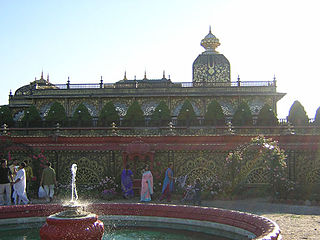
New Vrindaban is an unincorporated area and an ISKCON intentional community located in Marshall County, West Virginia, United States, near Moundsville. The town consists of 1,204 acres (4.87 km2), and several building complexes, homes, apartment buildings, and businesses including the Sri Sri Radha Vrindaban Chandra Temple and Prabhupada's Palace of Gold. New Vrindaban was founded in 1968 under the direct guidance of A.C. Bhaktivedanta Swami Prabhupada, founder of ISKCON, by his disciple Kirtanananda Swami. It is named for the Indian city of Vrindavan.

Hinduism is a minority religion in Hungary. According to the 2022 census, there were 3,307 Hindus in Hungary.

Harikesa Das, formerly known as Harikesa Swami and by the honorific Vishnupada, born Robert Campagnola, was one of the leading disciples of A. C. Bhaktivedanta Swami Prabhupada and a guru within the International Society of Krishna Consciousness. He left ISKCON in 1998.

Jayatirtha Das, formerly Jayatirtha Goswami was one of the leading disciples of A. C. Bhaktivedanta Swami Prabhupada and a guru within the International Society for Krishna Consciousness. Born James Edward Immel and also known as Bhakti Vijaya Tirtha, Tirthapada and Vijaya Acharya, Jayatirtha was appointed a life trustee of the Bhaktivedanta Book Trust by his guru, Prabhupada, who also placed him in the managerial post of the fledgling Spiritual Sky company. Under Jayatirtha's able management the company became a multimillion-dollar concern and the Wall Street Journal covered the company's success with a front-page article.
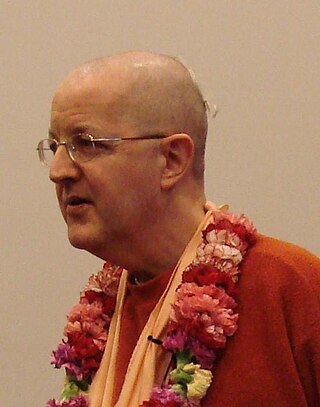
Romapada Swami is a Vaishnava sannyasi, initiating guru and is currently on leave as a governing body commissioner of the International Society for Krishna Consciousness.
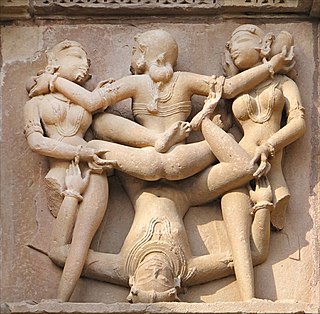
Hare Krishna views of homosexuality, and especially the view of the International Society for Krishna Consciousness (ISKCON) towards LGBT issues, are similar to their views of heterosexual relationships, i.e. because the living entity is identifying with the body, any attraction based on the desire to gratify the body and its senses is symptomatic of illusion and can be purified by progressively elevating the consciousness. Put simply, both hetero- and homosexual attraction is due to an illusory attachment to the temporary body. Same-sex relations and gender variance have been represented within Hinduism from Vedic times through to the present day, in rituals, law books, mythical narratives, commentaries, paintings, and sculpture. The extent to which these representations embrace or reject homosexuality has been disputed within the religion as well as outside of it.

An ISKCON guru is a person who is permitted to initiate disciples into the International Society for Krishna Consciousness system. The guru system has undergone several changes and reform since its beginnings in the 1960s. Upanayana as a traditional "sacred thread ceremony" of the Gayatri Mantra, commonly known Hindu Samskara, is complemented by Pancaratric mantras of the Gaudiya Vaishnava sampradaya and follows the principal initial nama initiation ceremony, referred to respectively as brahmana diksa and Hari nama diksa.

Sri Radha Krishna-Chandra Temple is one of the largest Krishna-Hindu temples in the world. It is situated in Bangalore in the Indian state of Karnataka. The temple is dedicated to Hindu deities Radha Krishna and propagates monotheism as mentioned in Chandogya Upanishad.

Tamal Krishna Goswami, born Thomas G. Herzig in New York City, New York, United States, served on the International Society for Krishna Consciousness's Governing Body Commission from its inception in 1970. He completed a bachelor's degree in religious studies at Southern Methodist University.

ISKCON Temple Chennai, also known as the Sri Sri Radha Krishna Mandir, is a Gaudiya Vaishnavism temple in Chennai, India. The temple is dedicated to Supreme Lord Krishna and His divine consort Radha. It was formally inaugurated on 26 April 2012.
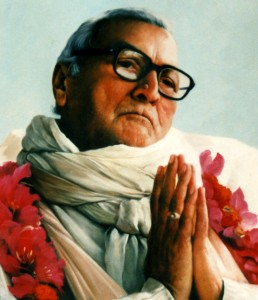
Bhakti Rakshak Sridhar was an Indian guru, writer, sannyasi and spiritual leader in the Gaudiya Vaishnava tradition of Chaitanya Mahaprabhu, founder-president-acharya of the Sri Chaitanya Saraswat Math.




















